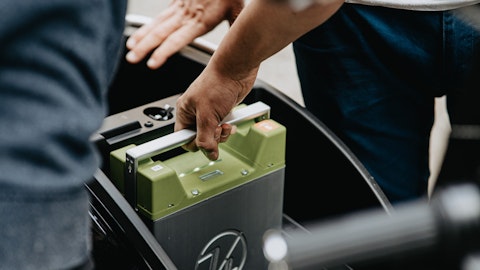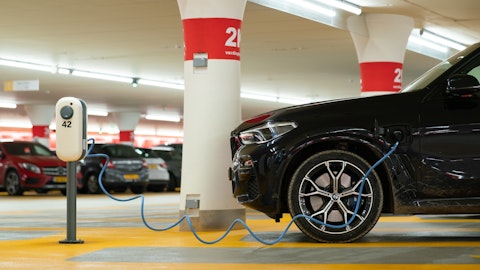Albemarle Corporation (NYSE:ALB) Q4 2022 Earnings Call Transcript February 16, 2023
Operator: Ladies and gentlemen, welcome to the Albemarle Corporation Q4 2022 Earnings Call. My name is Glenn, and I’ll be the moderator for today’s call. I will now hand you over to your host, Meredith Bandy, Vice President of Investor Relations and Sustainability. Meredith, please go ahead.
Meredith Bandy: All right. Thank you, Glenn, and welcome, everyone, to Albemarle’s fourth quarter and full year 2022 earnings conference call. Our earnings were released after the close of market yesterday, and you will find the press release and earnings presentation posted to our website under the Investors section at albemarle.com. Joining me on the call today are Kent Masters, Chief Executive Officer and Scott Tozier, Chief Financial Officer, Raphael Crawford, President of Ketjen; Netha Johnson, President of Specialties; and Eric Norris, President of Energy Storage are also available for Q&A. I’ll note that today’s call will be limited to 30 minutes shorter than our usual quarterly updates since we just held an in-depth update about three weeks ago.
The replay of that webcast is available on our website. As a reminder, some of the statements made during this call, including our outlook, guidance, expected company performance and timing of the expansion projects may constitute forward-looking statements. Please note the cautionary language about forward-looking statements contained in our press release and earnings presentation that same language applies to this call. I’ll also note that some of our comments today refer to non-GAAP financial measures. A reconciliation to GAAP financial measures can be found in our earnings release and the appendix of our earnings presentation. With that, I’ll turn the call over to Ken.
Kent Masters: Thanks, Meredith. Good morning, and thank you for joining us today. I’ll start by highlighting that our fourth quarter results were exceptional with close to triple the net sales from the same period in 2021 and adjusted EBITDA up more than 400% year-over-year. And while rising lithium pricing contributed to these results, we also saw significant increased volume growth. Scott will go into the financial details for the quarter and the year. We are confident in our assessment of the market opportunity for our essential elements and equally confident of our ability to seize that opportunity. We anticipate net sales growth of 55% to 75% for 2023. Our strategy is not just to maintain but to build on our global leadership in both Energy Storage and Specialties, and we continue to invest in both capacity and innovation to make that happen. And now I’ll turn it over to Scott for details.

Photo by National Cancer Institute on Unsplash
Scott Tozier: Great. Thanks, Kent, and good morning, everyone. Let’s start on slide 5 to quickly review the fourth quarter 2022 performance. Net sales for the fourth quarter closed at approximately $2.6 billion, up 193% from last year, driven primarily by our Lithium segment, but we saw increases in bromine as well. Net income attributable to Albemarle was $1.1 billion for the fourth quarter. Diluted EPS for the fourth quarter was $9.60, which was a record for Albemarle. In fact, it easily beat our previous full year EPS record of $6.34 back in 2018. Turning to slide 6. Fourth quarter adjusted EBITDA was over $1.2 billion, up almost 5.5 times year-over-year. This $1 billion increase was primarily driven by higher lithium prices and increased volumes.
As you can see on the slide, this high quarterly results also contributed heavily to our full year increase in adjusted EBITDA of nearly 300%. Our Bromine segment was up slightly. And as expected, our Catalyst segment came in lower in the quarter as higher sales volumes and favorable pricing were offset by a plant shutdown due to the winter freeze in Texas in December. Full year 2023 guidance is unchanged from our strategic update in January. We continue to expect strong sequential sales growth in 2023. And remember, we have assumed flat year-end 2022 lithium pricing throughout 2023. We expect our adjusted EBITDA to be approximately 20% to 45% higher than 2022, with positive trends in all three businesses. Additionally, we expect net cash from operations to rise between 10% and 25% over 2022.
And this means we expect to remain free cash flow positive this year even after increasing our growth investments. On slide 8, we expect to see net sales increase sequentially quarter-to-quarter, as our volumes ramp up. We project that our adjusted EBITDA will be evenly split between the first and second halves of the year. And as a result, we anticipate that margin rates will moderate as we progress through the year, and I’ll come back to that in a moment. All three of our business segments are looking at healthy growth rates during the year reiterating what we detailed in our January event. Since our webcast in January, a lot of the questions we’ve gotten are around margins and capital expenditures. So I’ll provide some additional color and time on those two items, and then Kent will provide a market update.
So let’s turn to slide 9. Energy Storage EBITDA margins were 65% in 2022. And then in 2023, a lower impact of spodumene inventory, and increased impact of our JVs is expected to normalize our 2023 margins to around 46% to 47%. Most of that roughly 20 percentage point decline is due to spodumene inventory lags. It takes about six months for spodumene to go from our mines through conversion to our customers. Last year, we saw dramatic increases in pricing for lithium and spodumene. And due to that time lag on spodumene inventory, we realized higher lithium pricing from our customers faster than higher spodumene costs. And as a result, we had unusually strong margins in 2022, particularly in the second half. The next item affecting margins is the accounting treatment of the MARBL joint venture.
We expect to report 100% of net sales, but only our share of EBITDA, resulting in a lower reported margin on that portion of the business. As this joint venture continues to ramp up, this accounting impact will increase. We are in active discussions with our partner about restructuring the MARBL joint venture and expect to have news on this soon. Finally, our EBITDA margins are impacted by tax expense at our Talison joint venture. Talison income is included in our EBITDA on an after-tax basis. If you adjust Talison results to exclude this, margins would be about 8% to 10% higher in 2023. Let’s turn to our capital expenditures outlook on slide 10. We are investing with three goals in mind. First, to add conversion capacity and remain vertically integrated; second, to invest in new product technology to support battery advances; and third, to build and maintain our world-class resource base.
To meet these goals, we expect capital investment to increase from about $1.7 billion to $1.9 billion in 2023 to about $4 billion to $4.4 billion in 2027. About half the increase in capital expense relates to geographic diversification to support customer demand for regional lithium conversion and supply. In 2023, we’re investing in our conversion capacity in Meishan in Qinzhou. And as the EV market develops in other parts of the world, we will continue to invest. For example, we are planning investments in North America and Europe, where we estimate capital intensity to be more than double. Second, by mid-decade, we expect to invest more in technology to produce advanced energy storage materials for next-generation batteries. And lastly, we expect to invest in additional resource development.
Across our capital spending, about 5% is linked to sustainability, including improvements to new and existing facilities. These investments are expected to generate strong returns, allowing us to continue to invest to support our customers while generating significant free cash flow. With that, I’ll turn it over to Kent for a brief market update and closing remarks.
Kent Masters: Okay. Thanks, Scott. As China reopens, we expect moderation in EV demand to be short-lived with medium and long-term demand remaining robust. We continue to expect EV sales in China to grow 40% year-over-year, an increase of nearly 3 million vehicles. As you can see in the chart on the right, sales in China are seasonally weak around the Lunar New Year. We believe the latest phasing out of subsidies will have limited impact on demand. EV subsidies have rolled off on schedule since 2013 with only brief declines in sales, continued municipal incentives and consumer preferences support a strong demand outlook for EVs. Our contract customers are not slowing down their ordering patterns and early indications are both that cathode inventory and battery inventory in China are decreasing, which is a good sign for lithium sales.
We’re listening to our customers, and we’ll be watching the data, so we’ll continue to adjust our expectation as the year progresses. Our biggest challenge is managing the tremendous growth opportunity that is in front of us. We are leveraging our durable competitive advantages like our world-class resources, our global asset portfolio and technical know-how to continue to grow. And we are being absolutely disciplined about how we build our leadership position, particularly when it comes to scaling lithium production and conversion. We intend to accelerate growth profitably and in ways that align with customer needs. We are confident that electrification will continue to be a primary pathway toward a clean energy future, but we also recognize that the future for Albemarle is built on more than electric vehicles and done more than just our production capacity.
As we said in our strategic update, our strength in transforming resources into essential elements give us outstanding leadership opportunities in four key areas: mobility, energy, connectivity and health. We know that customer-focused innovations and sustainability are as essential to our future as our resource capacity as we work to fulfill our purpose of enabling a more resilient world. So, now we’ll move to Q&A. And Glenn, you’re going to moderate that.
See also 10 Hot Insurance Stocks To Buy Now and 12 Countries that Export the Most Textiles.
Q&A Session
Follow Albemarle Corp (NYSE:ALB)
Follow Albemarle Corp (NYSE:ALB)
Operator: Thank you. Our first question comes from P.J. Juvekar from Citi P.J., your line is now open.
P.J. Juvekar: Yes. Hi, good morning everyone. Just a long-term question. As you get ready for Kings Mountain site to potentially restart in, let’s say, four or five years, I know you’re doing a lot of community outreach and engagement today. But can you lay out for us the milestones in terms of permitting process. And after the IRA, do you think the process has gotten any easier? Thank you.
Kent Masters: Okay. So, all right, interesting. So, I mean we are doing a lot of community outreach. It’s not so much about the permitting process. It’s just kind of how we’re doing business when we go about a project like this. So, — and we expect to continue to do that throughout the life of the mine as we do that and other mines and other sites as well. So, we’re just — we’re changing a little bit how we do that, learning from some of the success that we’ve had in Lithium business, and we apply that to our other sites as well, whether we’re mining there or not. But we’ll continue to see that outreach. On the — has the permitting process gotten easier since the IRA, I think there’s a tension on it. We are hopeful that it may be a little bit easier and streamlined, but I can’t — we can’t say that it’s gotten that way yet. That’s my view. And then some of the milestones in permitting, Eric, do you want to comment on that?
Eric Norris: I guess, P.J., good morning. I think that the first step would be permitting towards the latter as beginning to apply for permitting towards the latter half of this year. We’ve been in feasibility work on environmental side and sustainability side to prepare for that permit. And we have a permitting strategy that can get all the details on here, but I’d say leverage is the fact that it’s a brownfield site. So, we’re optimistic that even though there’s — as Kent said, there’s tension and attention on the permitting process that this particular mine, given its brownfield history, we’ll have hopefully a rapid review. So, we’ll continue to monitor that closely and update you accordingly.
Kent Masters: Yes. But even though we’re not — we’re filing for permits this year, we’ve been doing work on gathering data for that process for almost two years, I think, I’m not exactly sure how long, but for quite some time, the data that’s necessary for those permits, the history around everything that you have to report on to get the permits. So, it’s a process that takes a little time. And even though we haven’t formally filed yet, we’ve been working on that for a couple of years.
P.J. Juvekar: Thank you. I’ll pass it along.
Operator: Thank you, P.J. Your next question comes from David Begleiter from Deutsche Bank. David, your line is now open.
David Begleiter: Thank you. Good morning. Eric, just on lithium spot price in China, it’s not a major focus of ours. We have seen continued softening over the last few weeks. What do you make of that?





